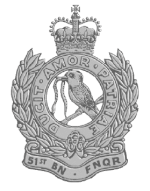51st Battalion, Far North Queensland Regiment
| 51st Battalion, Far North Queensland Regiment | |
|---|---|

Cap Badge of the Far North Queensland Regiment
|
|
| Active | 1916–19 1921–30 1936–43 1950–60 1965–76 1985 – Present |
| Country |
|
| Branch | Army |
| Role | Regional Force Surveillance |
| Size | One battalion |
| Part of | 6th Brigade |
| Garrison/HQ | Cairns |
| Nickname(s) | The Eyes and Ears of the North |
| Motto(s) | Ducit Amor Patriae (Patriotism Leads Me) (Latin) |
| March | Quick – The Far North Queensland Regiment (Band); The Black Kookaburra (Pipes and Drums) Slow – Soldiers of the North |
| Commanders | |
| Colonel in Chief |
HM The Queen (Royal Australian Infantry Corps) |
| Honorary Colonel | Colonel K. Ryan |
| Insignia | |
| Unit Colour Patch |  |
| Abbreviation | 51 FNQR |
The 51st Battalion, Far North Queensland Regiment (51 FNQR) is a light infantry battalion of the Australian Army. The battalion serves as a Regional Force Surveillance Unit (RFSU), carrying out reconnaissance and surveillance tasks as its primary role. Every operator in the unit is cross-trained in a variety of "low-visibility" skills such as weapons, survival, sniping, medic, small boat handling, driving, tracking, air ops etc. It is the only battalion of the Far North Queensland Regiment, and draws its lineage from an Australian Imperial Force (AIF) battalion, which was raised for service during World War I.
The 51st Battalion was originally raised in Egypt in early 1916 as part of the reorganisation and expansion of the AIF following the Gallipoli campaign. This was achieved by transferring cadres of experienced personnel predominately from units of the 1st Division to the newly formed battalions and combining them with recently recruited personnel who had been dispatched as reinforcements from Australia. The unit's first intake of personnel were drawn from men originating from Western Australia, many of whom had already served with the 11th Battalion during the fighting in Turkey. As a result, at the time of its formation, it inherited the battle honour awarded to the mounted infantry from Western Australia who served during the Second Boer War.
Under the command of Lieutenant Colonel Arthur Murray Ross, a regular British Army officer, the battalion—as part of the 13th Brigade attached to the 4th Australian Division—sailed for France, arriving in Marseilles on 12 June 1916. Shortly afterwards it was committed to the fighting, taking part in the Battle of Mouquet Farm during August and September. In three weeks, the battalion lost 650 men.
...
Wikipedia
